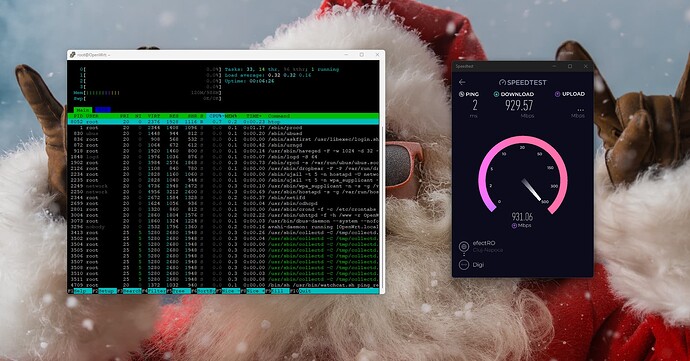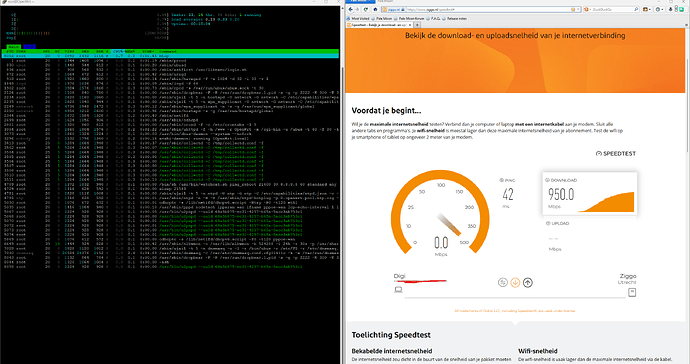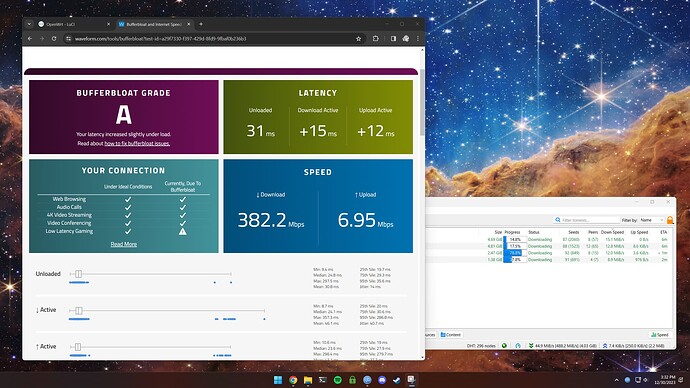I'm not sure that's needed, I have 5GHz set to 80MHz width and getting 700-800 Mbps download speedtest within 15ft of router.
I'm not seeing any issues with 802.11ax when used on either band.
If you look at the GL.iNet forums you'll see people mention poor 2.4GHz speed and range and the staff say that they're looking into it.
But the patch won't do anything for the 2.4 GHz band, since that's B/G/N/AX and doesn't support 160 MHz. And I have 2 devices that can use 802.11ax and both of them have no issues.
Posts on the GL.iNet forums suggest that the issue doesn't occur on devices that support 802.11ax. So, to replicate the issue you should connect an older device to the 2.4GHz band and then when you perform a speed test you shouldn't see more than 100 Mbps and at a distance you might have a stronger 5GHz signal.
You should read this post about what the patch actually does. Then you'd understand that the 2.4GHz radio doesn't support 802.11ac or 160MHz, so it's never going to cause an issue.
And like I've said, I've got two devices that support 802.11ax and both of them are working at full speed.
You should use /etc/modules.conf for snapshots. That way when you won't have to reapply the setting when you install firmware updates.
Can you try something for me with bufferbloat test and cake?
Start up a torrent (preferably in say qbittorrent) or even say Steam download throttle. Throttle your download limit to like half of your download speed. Qbittorrent > Tools > Options > Speed > Global Rate Limit
Now run the bufferbloat test. Do you still get A+?
On my OpenWRT hardware I'm seeing really bad 95 percentile ping and really bad jitter to a point I can't get A+. It's not shown if you do a bufferbloat test without any download throttling. I don't see the problem as much with fq_codel I can still get A+
Examples below:
Bufferbloat test on idle line: https://www.waveform.com/tools/bufferbloat?test-id=142211d3-7fac-4db4-861f-cc4a63e37362
Bufferbloat test while a download is throttled: https://www.waveform.com/tools/bufferbloat?test-id=c1304483-6794-46b4-87c1-7ca41217359c
Thanks
I took an initial pass at writing the doc page for this new device. Feel free to take a look and suggest any changes or impovements:
Thank you. I think your various suggestions have sped things up greatly for me.
Should the following options be suggested for both radio0 and radio1, since both beamforming and BSS colouring are an 802.11ax thing, not just a 5GHz thing? I am not sure, but that it the conclusion I came to reading the articles you linked in the doc page. I added these options for both radios and it seems to be running well.
option he_su_beamformee '1'
option he_bss_color '8'
@rygle see convo above with thedude. Beamform and BSS color are actually enabled by default. After some testing I'm going to remove that subsection. I've enabled/disabled and through some testing see no difference at various distances.
@gameinn i'll test out and get back to you
changed the thread name to a more generic one - hope you don't mind ![]()
Hostname OpenWrt
Model GL.iNet GL-MT6000
Architecture ARMv8 Processor rev 4
Target Platform mediatek/filogic
Firmware Version OpenWrt SNAPSHOT r24703-061a70d33c / LuCI Master git-23.357.52396-5355b7b
Kernel Version 5.15.145
Packet Steering-On
Software flow offloading-On
Hardware flow offloading-On
the tests were done on Lan 2
@oli Yea hardware flow offloading works great on this target, I get similar results and speeds. Meanwhile SQM does not seem as consistent on Filogic 830. Shockingly my 7 year old WRT32X (mvebu) has better performance with cake (as long as nothing else is being done on the router, be in Samba, WiFi, etc. where it becomes CPU limited).
@gameinn here you go, ran two tests with SQM fq_codel and Bittorent. One at 800/20 Mbps cap (hits ~750 Mbps if you add up the speeds shown in the pic), one at 600/15 Mbps cap (achieves a semi A+ rating, hits ~550 Mbps if you add up the speeds in pic)... but the ping spread is not ideal. Cake is simply a better algorithm for bufferbloat, but I'm not getting these speeds with that. Overall results aren't too bad, but I prefer the HFO+WED approach on this target.
I'm hoping kernel 6.1 improves things or maybe we find some irqbalance/affinity tweaks.
I also confirm slower wifi on OpenWrt snapshot vs GL.iNet stock after running iperf3 tests with "out-of-box" configs for each.
On 5.0GHz 80Mhz the stock shows 765 / 689 down/up vs only 436 / 471 for snapshot (SOF + HOF enabled). WED enabled improves somewhat the download to 458, upload unchanged.
On 2.4GHz 40Mhz the stock shows 108 / 144 down/up vs only 73 / 82 for snapshot (SOF + HOF enabled).
Edit: I was wrong with my conclusions above. If all OpenWrt wireless settings are changed to match the stock wireless settings (SOF+HOF+WED), including same channels and bandwidth (htmode HE40 for 2.4GHz, htmode HE80 for 5Ghz), the speeds are the same. I have ~90Mbps down on 2.4Ghz (rather congested band in my place) and ~780Mbps down on 5Ghz (using interference-free 5GHz channel). 5GHz speed matches what @phinn reported. But if I only switch to another 5GHz channel (with my neighbours present), the speed drops ~300Mbps to ~475-500Mbps.
I'm also a wrt1900acs v2 user, unfortunately I notice that for now the GL-MT6000 doesn't even have the perfect drivers and it's causing some problems on the wifi side.
I hope I won't regret that I made this switch from the old wrt1900acs v2 which does its job brilliantly, especially now on the wifi side, too bad it doesn't know DSA..
without any settings on the cable side
https://www.waveform.com/tools/bufferbloat?test-id=26de0d86-11a6-4464-9c04-c839098448ab
Do you regret the purchase? I'm still torn between buying this and TUF-AX6000.
I feel like if I buy this I'm really putting all my eggs in the OpenWRT basket but atleast with Asus if there is some wifi performance problems or whatever I can go back to stock and hope the drivers get sorted.
One thing I did notice is that the Asus has slightly upgraded wlan hardware than the GL-MT6000 (MT7976 vs MT7986) which might help driver problems but unlikely.
Did you ask on the TUF AX6000 thread to see what SQM results people have for this fairly intensive bittorrent / bufferbloat situation? It would be great to compare. Although I can only see that target performing slightly worse, unless I'm missing something about Asus SoC choices. Although both have Filogic 830, that device has 50% the RAM and 3% the storage capacity, although it uses different switch PHYs for 2.5G and 1G it looks like, that could perform differently.
I think these results can be improved over time with irqbalace/affinity tweaks. I'll be looking into it too.
All, In the meantime I reworked the BF/BSSC section of our doc since it's enabled by default at the driver level.
I think the WED made most difference, however perhaps the colouring one made a difference because my other router with the same SSID had it selected and I had not put my GL-MT6000 on the same "colour" until now. There should be a setting for that somewhere, since you can pick a particular colour/number.
Yea by far WED makes the difference for WiFi performance. I get 750-800 Mbps down if I'm in the same room as the router on 5GHz/80Mhz with it.
One thing I just don't understand is why it is a problem. I guess being a torrent with a big number of connections is messing up the algorithm. It's generally okay if you download from say: https://ubuntu.com/download/desktop
I wonder if configuring per host isolation would do anything.
There are a lot of things to look into. I'm wondering what high end hardware like x86-64 (say an N100) with i226-Vs would achieve. Would be nice to have a baseline for such an intensive test. I've been tinkering with affinity settings and irqbalance but haven't seen any big improvements.





